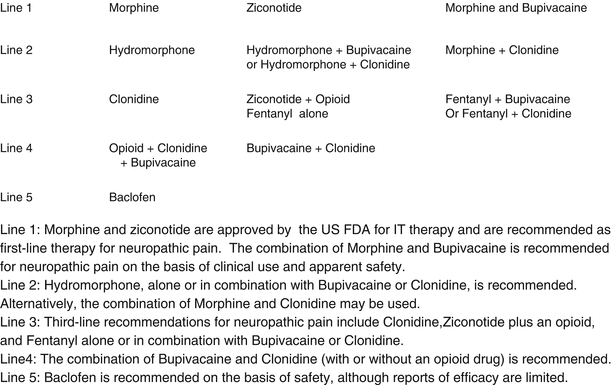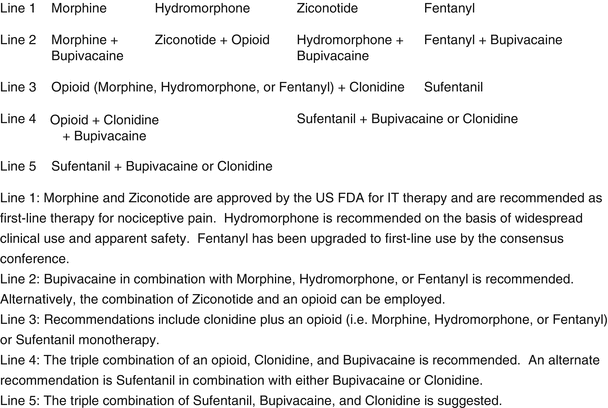The 2012 Polyanalgesic Consensus on medications used for intrathecal drug delivery systems also differentiates between optimal treatments for neuropathic and nociceptive pain [9] (Figs. 31.2 and 31.3).
31.2.4 Local Anesthetics
Local anesthetics have been used in the intrathecal space since the 1880s. Usually, local anesthetic is added to the intrathecal infusion when the patient reports neuropathic symptoms such as burning or electrical-type pain. Several studies have shown improved pain control when local anesthetic is added to an opiate infusion, due to their synergistic effects and potential opiate-sparing effect. Bupivacaine is stable in the infusion system, compatible with other drugs, and safe in animal models. Tetracaine is neurotoxic at high doses. Ropivacaine has not been thoroughly studied, but a prospective, crossover, double-blinded, randomized study by Dahm et al. [10] did not show any benefit to intrathecal ropivacaine use with respect to improved analgesia, urinary retention, paresthesia, and paresis with gait impairment.
31.2.5 Ziconotide
Ziconotide is made from snail venom and works as a selective N-type voltage calcium channel blocker. It is highly hydrophilic and may require several days to demonstrate efficacy (mean time to onset is 3–9.5 days). Staats et al. [11] compared the efficacy of ziconotide with normal saline in a double-blinded, multicenter, prospective, randomized control trial in cancer and AIDS patients. They were able to show improved analgesia, quality of life, and overall satisfaction. They reported side effects of dizziness, nausea, somnolence, vomiting, postural hypotension, and fever at doses >0.1mcg/h. It is unclear if ziconotide is more powerful as a monotherapy or in combination with adjuncts. Based on the results of Staats’ study, the FDA approved ziconotide for intrathecal use.
31.2.6 Opioids
Fentanyl can be considered for intrathecal infusion when morphine and hydromorphone have failed to offer analgesia or their side effects are prohibitive. Several small studies have shown the effectiveness of fentanyl in controlling pain. Mironer et al. [12] noted improved pain control with combination of fentanyl and bupivacaine when compared to fentanyl alone. No side effects were noted in either group.
Methadone has also been studied in the intrathecal space and may offer a unique advantage in that it possesses both opiate and NMDA receptor activity. Several studies have studied the efficacy of intrathecal methadone in cancer and noncancer patients. Patients received 5–60 mg/day for 3 days to 37 months. Methadone treatment consistently reduced pain and offered improved quality of life. However, patients reported vision changes and somnolence. The safety profile has yet to be clarified, and some animal studies indicate NMDA receptor drugs are linked to spinal cord injury [13].
31.2.7 Clonidine and Tizanidine
Clonidine is an alpha-2 adrenergic agonist which blocks nerve signal transmission of noxious sensory stimuli at the presynaptic and postsynaptic nerve terminals at the spinal cord level. Clonidine does not work at the opiate receptors and offers synergism when administered with opiates. Clonidine can be administered orally, transdermally, intravenously, epidurally, and intrathecally for treatment of a variety of pain syndromes. Clonidine is the only FDA-approved nonopioid intraspinal analgesic (although specified for epidural administration).
Hassenbusch et al. [14] performed a prospective open-labeled analysis of clonidine for cancer and noncancer pain. Thirty-one patients were treated with clonidine 144–1200 mcg per day with 22 patients reporting improvement in pain at 1 year. Once an effective dose was achieved, the patient rarely developed tolerance to the medication. They noted side effects of somnolence, hypotension, impotence, and urinary retention which limited dose escalation in a subset of patients. Ackerman et al. [15] showed limited improvement in pain control when clonidine is used as an adjunct. Additionally, they reported numerous side effects of hypotension, sedation, and pruritus. Tizanidine , traditionally used as a muscle relaxant, has a similar structure to clonidine as an alpha 2-adrenergic agonist. Tizanidine has similar potency to clonidine when administered intrathecally. A comparative dog study [16] showed similar efficacy of both agents, but tizanidine had fewer adverse effects of bradycardia and hypotension.
31.2.8 Octreotide
Octreotide is a growth hormone analogue which may play a role in alleviating chronic pain when administered intrathecally. Deer et al. [17] performed a randomized, prospective, double-blinded study which did not show a statistically significant improvement in pain. However, no side effects were noted, and the dose of the medication may have been inadequate.
31.2.9 Gabapentin
Gabapentin’s role in treating neuropathic pain has been established. Intrathecal gabapentin has been studied in humans without side effects. The drug reduced mechanical allodynia, diminished hyperalgesia, and reduced neuropathic pain in rats as a mononeuropathy. It is more effective and potent when given intrathecally [18]. Gabapentin may be efficacious as monotherapy or an adjunct.
31.2.10 Complications of IDDS
In 2006, a cluster of three deaths were noted within 1 day of IDDS implant (nine cases were later identified). This was thought to be opiate related and prompted a review of mortality related to IDDS. Coffey et al. [19] performed a study looking at mortality associated with IDDS relative to spinal cord stimulation implantation (a similar procedure) and lumbar discectomy. They utilized epidemiological methods along with the Medtronic device registration data from Social Security Death Master File and UnitedHealthcare population database to examine demographic/comorbidity data. This analysis revealed an intrathecal mortality rate of 0.088% at 3 days after implantation, 0.39% at 1 month, and 3.89% at 1 year (all higher than SCS implantation or lumbar discectomy in community hospitals). They attributed the excess mortality to intrathecal opioid therapy. Upon review of these sentinel cases, respiratory arrest was either the cause or contributed to patient death. No device malfunction was noted. They concluded that patients with noncancer pain treated with IDDS opiate therapy had increased mortality rates when compared to patients treated with other therapies. Given these findings, they identified physician practices that increased patient mortality.
In 2013, Prager et al. [20] composed the “Best Practices for Intrathecal Drug Delivery for Pain” article. The goal of this expert panel was to identify best practices and provide guidance for clinicians to ensure safety and pain control with IDDS. While device-related issues such as catheter complications or surgical site infections occur, the main safety issues involve inadequate patient monitoring, inflammatory mass, wound healing, dosing errors, pump refills, and interactions with systemic medications. Thus, many of these complications were preventable with clinician education. They identified three areas of focus: patient selection and trialing, safety and monitoring, and patient and device management.
31.3 Patient Selection and Trialing
Patient selection is critical to the success of an IDDS. There are a myriad of chronic pain states that may be treated with an IDDS. The expert panel noted that patients with headache, fibromyalgia, atypical facial pain, noncancer head-neck pain, and borderline personality disorder had poor responses to IDDS. Additionally, patients who cannot partner with the physician in management of the IDDS should not be implanted. Comorbidities such as sleep apnea, restricted cardiac or lung capacity, venous insufficiency, obesity, metabolic syndrome, hypertension, diabetes, and immunosuppression placed patients at an increased risk for complications. These patients need to be optimized and understand they are at increased risk. Patients with spinal stenosis may also benefit from IDDS if the catheter is placed above the conus medullaris, and the patient has stable neurologic signs. Litigation is not a contraindication to IDDS placement, but the clinician should be on alert for secondary gain [20]. Absolute contraindications include active drug use, coagulopathy, and obstruction of CSF flow. Patient on chronic anticoagulation may be candidates for IDDS but will need guidance for anticoagulation management. Any patient with psychiatric comorbidities will need a psychological evaluation prior to IDDS trial.
As discussed earlier, there are no specific guidelines for intrathecal trialing, but the panel did strongly encourage intrathecal trialing prior to implantation. There was discussion of bypassing the trial in cancer patients with severe pain who could not tolerate the side effects of systemic opiates. The panel noted that single-dose trials were acceptable for ziconotide but not ideal for opiates. Overnight observation is recommended for opiate trials. Patients with OSA are encouraged to continue treatment throughout the trial. Pain relief and functional capacity improvement need to be assessed in determining the success of the trial.
31.4 Safety and Monitoring
The patient must be able to understand and comply with the management of the IDDS. At each visit, the clinician must review an active medication list, including over-the-counter medication. Additionally, the patient must be asked about drug and alcohol use in addition to routine urine drug screens to monitor compliance. Patients should be asked about their pain, functional capacity at home, changes in their pain perception, and new neurological symptoms.
As indicated by Coffey’s [19] study, respiratory depression is the primary safety concern with IDDS. The ASA classifies respiratory depression in the context of neuraxial opioid administration as reduced respiratory rate (<10–12 breaths per minute), reduced oxygen saturation (<90–92%), hypercapnia/hypercarbia (arterial CO2 > 50 mm HG), or clinical signs of drowsiness, sedation, periodic apnea, or cyanosis. Many cases of respiratory depression can be prevented by a pretrial urine toxicity screen and full disclosure of other central nervous system depressants. Coffey et al. [19] noted the patients with fatal respiratory depression after IDDS were taking between one and nine concomitant drugs including sedatives, hypnotics, oral and transdermal opioids, antidepressants, tranquilizers, and antihistamines.

Full access? Get Clinical Tree








